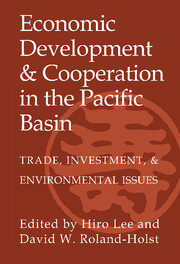 Economic Development and Cooperation in the Pacific Basin
Economic Development and Cooperation in the Pacific Basin Book contents
- Frontmatter
- Contents
- Acknowledgments
- List of Contributors
- I Introduction and Overview
- II U.S.-Japan and Asian Trade Patterns
- III Regional Trading Arrangements in the Pacific Basin
- 4 Should East Asia Go Regional?
- 5 Political Feasibility and Empirical Assessments of a Pacific Free Trade Area
- 6 Regionalism in the Pacific Basin: Strategic Interest of ASEAN in APEC
- IV Foreign Direct Investment: Determinants and Consequences
- V Trade, Resources, and the Environment
- Index
6 - Regionalism in the Pacific Basin: Strategic Interest of ASEAN in APEC
Published online by Cambridge University Press: 19 May 2010
- Frontmatter
- Contents
- Acknowledgments
- List of Contributors
- I Introduction and Overview
- II U.S.-Japan and Asian Trade Patterns
- III Regional Trading Arrangements in the Pacific Basin
- 4 Should East Asia Go Regional?
- 5 Political Feasibility and Empirical Assessments of a Pacific Free Trade Area
- 6 Regionalism in the Pacific Basin: Strategic Interest of ASEAN in APEC
- IV Foreign Direct Investment: Determinants and Consequences
- V Trade, Resources, and the Environment
- Index
Summary
INTRODUCTION
The unprecedented expansion of world output and trade in the post-World War II era provided the East Asian economy of Japan and the four newly industrialized economies (NIEs) of South Korea, Taiwan, Hong Kong, and Singapore with a favorable international environment for export-led growth. These countries were able to embark on the path of industrial catch-up when the gust of wind was strongest. While Japan's growth rate has slowed down considerably after the first oil crisis of 1973–74, the four East Asian NIEs have become the most dynamic economies in the world during the past three decades. Their annual growth rates of per capita GNP during the 1965–95 period averaged 6 to 8 percent, triple the average rate of 2.3 percent for middle-income economies and almost double the 4.0 percent average for countries in the Association of Southeast Asian Nations (ASEAN) excluding Singapore.
Thus, with the benefits of latecomers in the process of industrialization and taking full advantage of the conducive world trading system, as well as the ideological imperatives of the free world, the NIEs have been able to telescope an industrialization process that took the OECD countries 100 to 150 years to complete in the nineteenth and early twentieth centuries into 25 to 30 years in the postwar era. However, unlike Japan, they have industrialized with a greater degree of dependence on foreign direct investment (FDI), particularly for Singapore. Throughout the 1980s and the first half of the 1990s, foreign firm exports accounted for about 80 percent of total exports for Singapore, 25 percent for Korea, 15 percent for Taiwan, and 20 percent for Hong Kong.
- Type
- Chapter
- Information
- Economic Development and Cooperation in the Pacific BasinTrade, Investment, and Environmental Issues, pp. 203 - 230Publisher: Cambridge University PressPrint publication year: 1998


